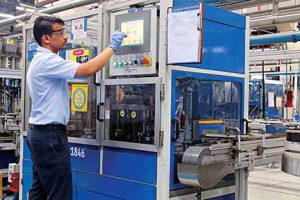In part two of this feature, Deepti Thore looks at the ongoing efforts to strengthen resilient supply chains further and be future-ready.
 In part one of the feature ‘Building Resilient Supply Chains’, we looked at how stakeholders of the automotive industry including tier suppliers are strengthening resilient supply chains in the aftermath of the pandemic. With the importance of risk management and continuity plans to avoid supply chain disruptions being realised across the board, the attention is back to turning future-ready and unlocking long-term plans beyond safeguarding short-term business interests. To walk the talk, the industry continues to adopt digitisation in the value chain and innovate on fronts like the Artificial Internet of Things (AIoT). To tackle the global demand, many players have resorted to opening the global Centre of Excellence and R&D hubs in India as the biggest centres outside their home grounds.
In part one of the feature ‘Building Resilient Supply Chains’, we looked at how stakeholders of the automotive industry including tier suppliers are strengthening resilient supply chains in the aftermath of the pandemic. With the importance of risk management and continuity plans to avoid supply chain disruptions being realised across the board, the attention is back to turning future-ready and unlocking long-term plans beyond safeguarding short-term business interests. To walk the talk, the industry continues to adopt digitisation in the value chain and innovate on fronts like the Artificial Internet of Things (AIoT). To tackle the global demand, many players have resorted to opening the global Centre of Excellence and R&D hubs in India as the biggest centres outside their home grounds.
Commenting on the advances made, Mayur Danait, Chief Information Officer at Pidilite Industries Ltd opined, “There are two things that are driving the change in the supply chain which include the push coming from technology including cloud technology, smart sensors, IoT and algorithms. There is a constant push on how you can modernise the supply chain.” In contrast, Danait cited external pull factors playing a part in shaping the supply chains. “ The complexity of the supply chain constantly keeps going up courtesy of e-commerce and as a result pressurising service models. There is also some amount of regulation which further promotes the adoption of digitisation,” he shared.
Digitisation in supply chains
Digitisation is inevitable, asserted Jayaraman Krishnamurthy, Industry Strategy-o9 Solutions, Inc. This is backed by multiple studies. For example, according to a Grant Thornton study, from production to supply chain, the auto industry is witnessing it all. Connectivity, the IoT, wireless solutions, adoption of electric vehicles, embedding AI and Augmented Reality (AR). From manufacturers to dealers, every stage of automobile sales has embraced digitalisation, it points out. The focus is on capturing real-time data to help stakeholders make strategic decisions based on an end-to-end overview of the supply chain. The efforts to bring in transparency at every layer are fructifying and empowering companies to forecast imminent disruptions and prepare for them.
Streamlining processes
There is a greater emphasis today on the use of technology to streamline the processes and promote efficiency at every stage. This has meant greater participation from outliers and ancillaries like technology suppliers offering retooling production operating systems to turn leaner, agile, and nimbler. On-demand warehousing has been identified as one of the more innovative ways of addressing common pain points like scouting for lesser capital-intensive, contract warehousing. For example, MG Group inaugurated a contract warehousing facility christened ‘MG EV Park’. It is not far-fetched to expect collaborative robots (Cobots) driven automation at such facilities. It is known to enhance efficiency and productivity levels. To make the chains transparent, the industry is adopting blockchain which makes backtracking possible. In the automotive industry, blockchain aids in tracking parts and identifying counterfeits. Tagging, sensors and geolocation technologies are also in use.
Crowd shipping
 Crowd shipping or crowd-sourced delivery is the method of delivering packages to customers through nonprofessional and local courier services. As companies struggle to meet customers’ every growing delivery demands and compete with giants like Amazon, the delivery method is known to help uplift supply chain efficiency. More importantly, it helps create a centralised platform for delivery management. Crowdshipping is also bringing transformation in last-mile delivery. It helps bring down the delivery costs and offers more flexibility. Logistics costs in India are at 13-14 per cent of the GDP and must settle around seven to eight per cent levels. Crowdshipping supports risk management strategies as it offers more visibility into where risk events may occur, and help understand their financial implications. The impact of crowd sourcing on mitigating supply chain risk is also apparent in technology that enables companies to communicate and collaborate with their suppliers in real time. Today, both traditional and emerging companies have also deployed crowd sourcing to transform the way they design and develop new products.
Crowd shipping or crowd-sourced delivery is the method of delivering packages to customers through nonprofessional and local courier services. As companies struggle to meet customers’ every growing delivery demands and compete with giants like Amazon, the delivery method is known to help uplift supply chain efficiency. More importantly, it helps create a centralised platform for delivery management. Crowdshipping is also bringing transformation in last-mile delivery. It helps bring down the delivery costs and offers more flexibility. Logistics costs in India are at 13-14 per cent of the GDP and must settle around seven to eight per cent levels. Crowdshipping supports risk management strategies as it offers more visibility into where risk events may occur, and help understand their financial implications. The impact of crowd sourcing on mitigating supply chain risk is also apparent in technology that enables companies to communicate and collaborate with their suppliers in real time. Today, both traditional and emerging companies have also deployed crowd sourcing to transform the way they design and develop new products.
Manufacturing repurpose
One way to keep the supply chain working is to repurpose the manufacturing. It is a rapid response solution in case of crisis brought upon by situations like the pandemic. Re purposing is a method in which the existing manufacturing system or process is altered to adapt the disruptions caused. According to Kearney, there are three universal steps to help quickly identify the best-fit manufacturing segments for re purposing and generating additional production capacity. The steps involve analysing the production characteristics of each vital product and match against relevant industries, assessing the capacity projection for current business with relevant industries and prioritising. For example, parts from existing models are known to be fit into orders pending delivery. According to one of the papers titled ‘Barriers in re purposing an existing manufacturing plant: a Total Interpretive Structural Modelling (TISM) approach’ authored by Aadarsh Poduval, Maruti Sriram Ayyagari, Mohit Malinda, Anil Kumar, Vimal K.E.K and Jayakrishna Kandasamy and published on Springer, re purposing makes the manufacturing plant adaptable to changes, makes it productive by manufacturing products that are currently in demand, prevents the dissolution of the plant and thus harvests the maximum potential of the manufacturing plant in the need of an emergency. ACI













